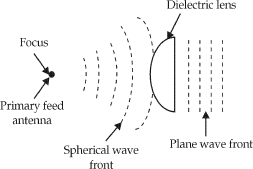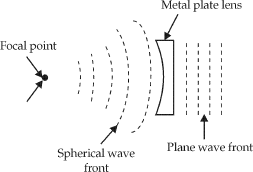Table of Contents
Lens Antenna
Lens Antenna is an antenna that consists of an electromagnetic lens with a feed. In other words, a lens antenna is a three-dimensional electromagnetic device whose refractive index is different from unity. It acts as a glass lens in optics.
They are usually made of polystyrene or Lucite. They are used to:
- Control the aperture illumination.
- Collimate the electromagnetic rays.
- Produce directional characteristics.
- Converge the incoming wavefront at its focus.
- Produce plane wavefront from the spherical wavefront.
Principle A lens antenna in association with a primary feed antenna in transmitting mode is shown in the figure below.
When the feed is kept at the focal point of the lens antenna, the diverging rays (spherical wavefront) are collimated (parallel rays) forming a plane wavefront after their incidence on the lens and passing through it. Collimation occurs because of the refraction mechanism.
Lens antenna in the receiving mode is shown in the figure below.
Here again, incoming parallel rays converge at the focal point after passing through the lens due to the refraction mechanism. This is an indication of the validity of the reciprocity theorem. Collimation is also possible if the lens has a refractive index less than unity. Lens antennas are used in association with a point source (ideally). But in practice, it is used with horn-like antennas.
Types of Lens Antenna
These are of two types:
- Dielectric lens.
- Metal plate lens.
Dielectric lens
The dielectric lens is also known as the delay lens. Here, outgoing electromagnetic rays are collimated and are retarded or delayed by the lens material or media. This is illustrated in the figure below.

Metal plate lens
E-plane metal plate lens: in this, the outgoing wavefront is speeded up by the lens material. This is shown in the figure below.
The dielectric lens is again of two types:
- Non-metallic dielectric type.
- Metallic type.
Salient features of dielectric lens antenna
- They are usually made of polystyrene or lucite and polyethylene. Dielectric constant of polystyrene ∈r = 2.56, refractive index, n = 1.6 For polyethylene, ∈r = 2.25, n = 1.5.
- They are bulky and heavy for f < 3 GHz.
- Uniform illumination for lens antennas is better if the focal length is long.
- At f < 10 GHz the lens become excessively and undesirably thick.
- The main disadvantage of the dielectric lens is its frequency sensitivity.
- The un-stepped dielectric lens is wide-band and its shape does not depend on wavelength.
- The main advantage of lens antennas is that the feed antennas do not obstruct the aperture.
- Tolerance in the design of this antenna is more.
- Feeding at a point away from the axis is possible and it is suitable to move the beam angularly with respect to its axis if required.
- Lens antennas are costlier for similar gain and bandwidth in comparison with reflector antennas.
- They are also bulky and heavy. Designing is involved.
Merits and Demerits
- In lens antenna, feed and feed support do not obstruct the aperture, as the rays are transmitted away from the feed.
- It has greater design tolerance i.e., a larger amount of wrapping and twisting is possible in lens antenna as the wave enters one side emerges at the other side, maintaining the electrical path length.
- It can be used to feed off the optical axis and hence useful in application where the beam is required to be moved angularly w.r.t. axis.
- Lenses are usually bulky, and heavy.
- This antenna is complicated in design.
- It is costlier for the same gain and bandwidth in comparison with reflectors.
Application
- Unstopped dielectric lens is a wideband antenna as its shape does not depend on the wavelength and hence can be used over a wide frequency range.
- Lens antennas are commonly used above 1000 MHz.
- It being a microwave device, is performed to be used usually above 3000 MHz and not below.






